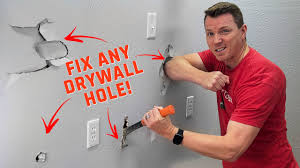If you’re seeing damaged walls and ceilings in your home, then it’s the perfect time to make some repairs. The interiors of many homes are covered with Gypsum wallboards, often known as drywall. It is sturdy to an extent, but after couple of years, you’re likely to notice holes, cracks and scratches, particularly when you have children or pets who cause nuisance.
Fortunately, most of the damage to drywall can be repaired. You’ll need only basic tools, the appropriate materials as well as a few techniques to employ. This step-bystep DIY guide will help you patch small holes as well as large holes and corner bead repair. However, first, you must assess the damage.
Review The Detriment
When you visit the local hardware store make sure you examine the extent of the drywall that you’re taking a look at.
A couple of nail holes? You’ll need joint compound, which is also referred to as spackle and a putty blade, as well as the Sanding Block.
Are you in the middle of a large gap? It is likely that you will require more than the minimum. Anything larger than a nail will require mesh tape to strengthen and hold the drywall the mud. Mesh tape is great for the most severe cracks and coins-sized holes. The larger holes require a second piece of wall.
Materials required
- The drywall saw
- reciprocating saw
- Electronic stud finder
- hacksaw
- Pry bar
- tape measure
- Aviation cuts
- Carpenter’s square
- The drywall corner bead string
- fiberglass the drywall tape
- The wall
- Wood and cleats
- joint compound
1. Repair small pockmarked hole
- Create a patch that is slightly larger than the hole from pieces of drywall that are similar thickness to the wall. The patch must be placed on top of the hole and then trace the area around it with the pencil.
- Create lines with the drywall saw. Take out the damaged wall. Put 1″x 4-” cleats in the wall in front of the hole, and secure them with screws for drywall.
- Install the patch of drywall in the hole and attach it onto the cleats by using screws designed for drywall. The patch must be covered by joint compound. Finally, apply pieces of drywall tape along the seams.
- Make sure the joint is smooth with the aid by a 6-” knife for drywall, and allow it to dry.
- Apply two coats with the 10-” wall knife, spreading the compound evenly across the surface.
- Once that the glue is dry polish the compound prior to painting and painting and.
2. Repair Large Holes
The larger the hole bigger, the more complex repair will be. However, with the right tools and solid hands, you can fix them yourself.
Find the Studs
Utilize an electronic stud locater to determine the studs beneath the repaired drywall. Utilize drywall, or a reciprocating saw, to cut off the drywall. Make sure not to cut through the studs. Take away as much wall as you need until you reach the studs which extend over all the sides of the damaged region. Then, take the drywall away and clean off the screws and nails.
Install Wood Cleats
Install wood cleats onto each stud on the opposite side of the hole in order to keep the edges of the new drywall horizontally. If you’re replacing an enormous sheet of drywall, you can strengthen the opening with 2×3 lumber. Cut the cleats two inches bigger that the opening. Set the cleats in an even line with the studs’ surfaces that are set and then install them using screws or nails for drywall.
Install New Drywall
Measure, cut and then install a new drywall that matches the area that was repaired. Be sure to apply the same drywall that was the thickness of your previously put up wall. Walls in the interior are generally constructed with a drywall thickness of one and a half inches. But, there are some places that require extra sturdy or safer wall lining between a home as well as a garage attached. Utilize drywall screws to join the drywall Cleats or any of the studs between, like in new construction. Tape the joints the joint compound should be applied following the steps previously mentioned.
3. Corner Bead Repair
When two sheets of drywall meet at the corner of an exterior wall They are secured with a strip of metal with the form of an L known as the corner bead. Corner beads are secured to the corners and later covered with the three to two layer of joint materials. The corner beads made of metal are sturdy, but not impervious to damage.
Cut the Corner Bead
Utilize a hacksaw for cutting the corner bead approximately 2 inches in between the damaged and undamaged portion. The next step is to use the blade to cut the bottom of the horizontal corner. Make sure you cut your joint’s compound. Cut the broken corner bead from the wall using a small pry bar and straight-blade screwdriver. Be careful not to scratch the wall surface within the bead.
Repair this New Corner Section
After that, you can use a pair of aviation snips to cut a new corner and then replace the damaged one. Put the piece back in its position and secure it using 1 1/2-inch-long drywall nails that have extremely small head and smooth sides which can be concealed by using joint compound rather as opposed to screws for drywall. Utilize up to 3 coats of joint compound, making sure to smooth between coats. Spread the third coat by using an 8-inch drywall blade. Then prime and paint the drywall so that it will be a similar color to the wall you originally painted.
4. Extreme Damage
Sometimes the damage is so extensive that you’re called upon to consult with a professional. The large holes could suggest that the wall needs to be completely replaced as the cost of repair will be more than replacing it. If your drywalls are suffering by water, this could ruin your wall from the outside in. The affected part can be cut off and rebuilt in the event that you notice the problem early enough. If the issue persists for a long period it could have been damaged to the point that it is no longer worth repair. This is a situation which is best left to professionals.















